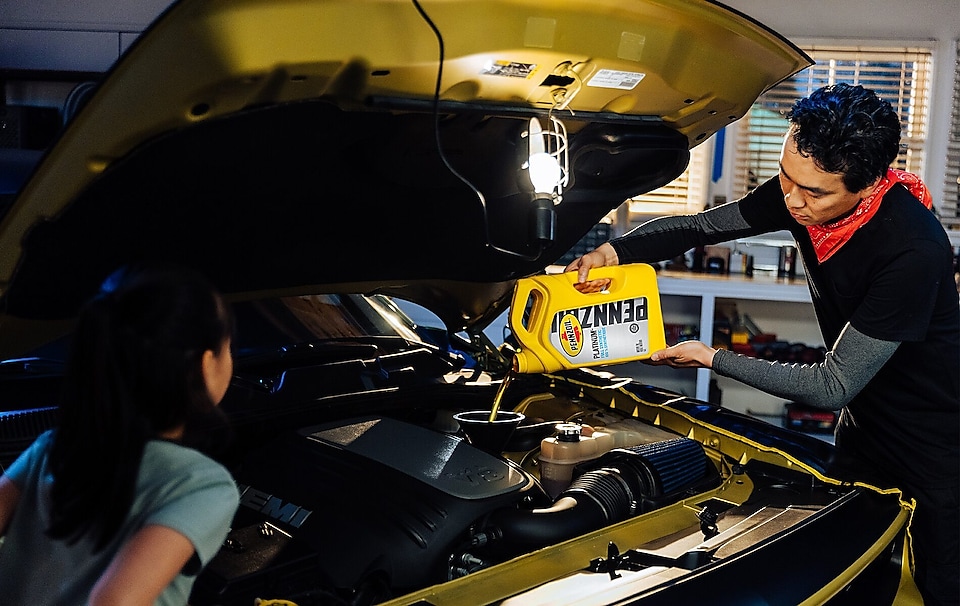
Should You Extend Your Vehicle’s Oil Drain Interval?
Extending your vehicle’s oil drain interval isn’t necessarily a good thing.
Extending your vehicle’s oil drain interval is not as important as protecting your engine’s parts throughout the entire interval. Driving conditions like stop and go driving, driving on dusty, gravel, or salted roads, driving in extreme temperatures, or towing may actually necessitate a shorter drain interval. Extending your oil drain interval may also void your vehicle manufacturer’s warranty.
You should always follow your vehicle manufacturer’s recommendation for oil drain intervals. Make sure to use a product that will offer you complete protection for the duration of your vehicle’s interval, like Pennzoil Synthetics, for top engine performance.
Know Your Oil: Should You Extend Your Oil Drain Interval?
PENNZOIL Transcript—Canada/Education/Know Your Oil/Should You Extend Your Vehicle’s Oil Drain Interval?
[Title] Know Your Oil: Should You Extend Your Vehicle’s Oil Drain Interval?
Description: Shanna from Pennzoil discusses oil drain intervals
[In vision]
Shanna stands at a workbench, surrounded by automotive tools.
[Insert: Topic card to her left: WEAR PROTECTION AND DRAIN INTERVAL]
Shanna: Hi, I’m Shanna, and you’re watching “Know Your Oil,” brought to you by Pennzoil. In this video, we are back, once again discussing wear protection. This time, we’re going to focus on both anti-wear strength and oil drain intervals.
[Background music plays] Program theme, quick guitar riff with drums
[Title card/”garage door”]
[Pennzoil logo]
[Pennzoil] Presents Know Your Oil
[In vision]
Shanna holds up a couple of engine parts as she speaks about them. To her left is an insert with an animated clip of pistons going up and down in an engine.
Shanna: Camshaft lobes, valve followers and crankshaft bearings are just a few areas inside your engine that are prone to wear. These metal parts absorb high impacts and can accumulate surface damage if they don’t have proper wear protection. That’s where Pennzoil Synthetics save the day. [Insert: A bunch of hands with thumbs up] [Sound: Ding!]
[Insert: Animation of an engine turning, then images of the engine parts Shanna speaks about]
Shanna: The amount of anti-wear additives such as phosphorus and zinc in motor oil formulations are regulated by API ILSAC because, over time, they can harm vehicle oxygen sensors and catalytic converters, rendering them less effective.
In addition to these restrictions, anti-wear additives are depleted or used up over time. So, in order to ensure constant optimal protection, you need to follow the oil drain intervals set by the vehicle manufacturer. [Shanna holds up two owner’s manuals. Then, points at the viewer.] No deviance!
[Insert: Card that says, “EXTENDED DRAIN INTERVALS”. Then, a running odometer going up to 5000, then 10000, then 15000, 15000 and up, as Shanna speaks.]
Shanna: Now, be careful if you see a motor oil advertising extended oil drain intervals, because it’s not about extending the oil drain interval or making it last longer, but providing lasting wear protection throughout the entire oil drain interval. Plus, certain high-performance engines are prone to oil consumption, so extending your oil drain interval is only going to make this problem worse.
[Insert: Close-up of a dashboard with red engine oil light on]
Shanna: Not to mention extending your oil drain interval may void the manufacturer’s warranty. [Game show “X” and “fail” sound: Buzz!]
[Insert: Video clip of cars zooming on a freeway and then coming to a dead stop. A car churning up gravel behind it. Sun setting on a stretch of desert, lone car on the highway. Pickup towing a trailer. Shanna counts each with her fingers as she mentions them.]
And if you fall into the severe-driving category—which includes stop-and-go driving, trips less than 10 miles, driving on dusty gravel or salted roads, extreme temperatures, or towing—then don’t even think about extending your oil drain interval.
[Insert: Highlighted copy from an owner’s manual that says, “Severe Operating Conditions can cause the change oil message to illuminate as early as 3,500 miles (5,600 km) since last reset. Have your vehicle serviced as soon as possible, within the next 500 miles (805 km). NOTE: Under no circumstances should oil change intervals exceed 10,000 miles (16,000 km), twelve months or 350 hours of engine run time, whichever comes first. The 350 hours of engine run or idle time is generally only a concern for fleet customers.]
In fact, you may need to change your oil more frequently.
So, in summary, always follow the vehicle’s owner’s manual. [Holds up two manuals.]
Make the switch to Pennzoil Synthetics and enjoy complete engine protection.
[Background music plays] Program theme, quick guitar riff with drums.
[End card/”garage door”]
[Pennzoil logo]
[Pennzoil] Presents Know Your Oil
